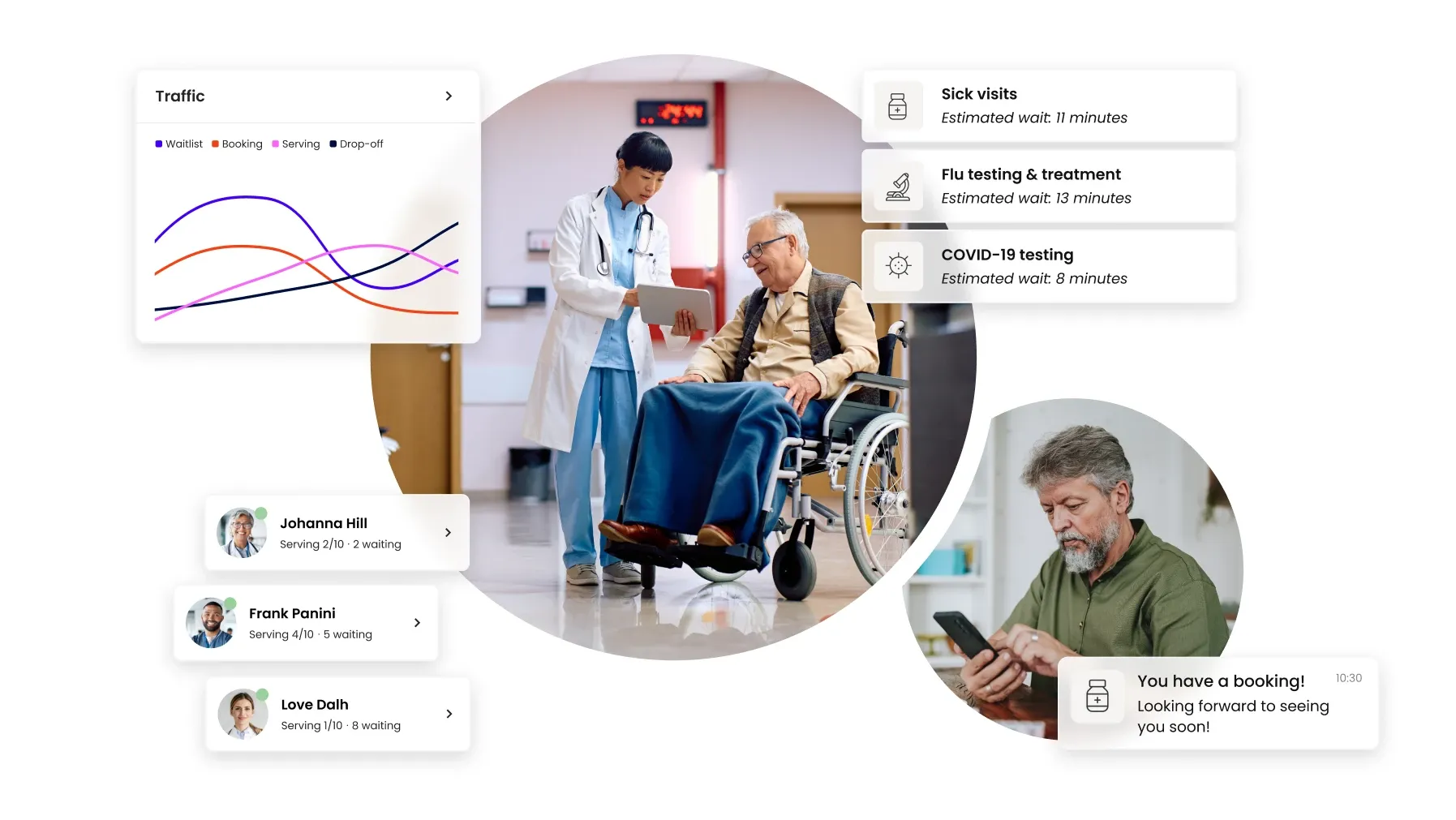Patient waitlist management for hospitals
Ensuring the efficient management of patients waiting is crucial for any healthcare practice. Read our intro to waitlist management for hospitals.

It's well-known that the waiting game at hospitals can be frustrating. Every year, millions of patients are placed on waitlists. In the U.S. alone, patients spend a median of 103 minutes waiting for a hospital room.
A hospital waitlist is a list of patients who are awaiting treatment or admission to the hospital. The need for a waitlist can arise for a number of reasons, including:
- There are not enough beds available in the hospital
- The patient needs to see a specialist who is not immediately available
- The patient needs surgery, but there’s a backlog of scheduled procedures
Regardless of the reason, being on a hospital waitlist can be a stressful experience for patients and their families. That's why it's important for hospital administrators to understand how patient waitlists work and what they can do to help reduce the amount of time patients spend on them.
The intricacies of patient management can be complex, given the importance of triaging patients based on the severity of their condition. Unlike a waitlist at a retail establishment, for example, a hospital waitlist most likely will not function on a first-come, first-served basis. The process of triaging is a delicate one – and the waitlist system you employ should excel at making all patients feel that they are being treated equally.
A great hospital waitlist app will unlock automation that will allow you to serve patients faster and streamline operations. Keep reading to learn what to look for in a digital solution and to get tips for how to implement virtual queues for patient management.
We’ll cover:
- How patient management is unique compared to other industries
- How digital patient waitlist management apps work
- Essential features of a patient waitlist management solution
- Tips for how to improve the patient waiting experience
Unique aspects of patient management vs. other industries
The big difference between hospitals and other service industries is that people usually don't choose to come to the hospital. An ambulance brings them in, or they come in after their doctors refer them. More often than not, patients have no choice but to wait for treatment. This can be frustrating, especially if they are in pain or their condition worsens. Feeling like they don’t have much control over the situation, patients can get overwhelmed and angry quickly.
There are a few different ways that hospitals manage their waitlists. The most common method is first-come, first-serve. This means that the patient waiting the longest will receive treatment first. However, this method can be unfair – and dangerous – to patients who have urgent needs.
To combat this, some hospitals use a triage system. This system prioritizes patients based on the severity of their condition. Patients with life-threatening conditions are treated first, followed by those with less serious conditions.
There are two core ways to manage a patient waitlist: manually or through a waitlist app.
Manual waitlisting is inefficient to run as it requires staff resources to manage. Plus, it’s difficult to keep patients updated on their status, leading to frustrating waiting experiences.
With a waitlist app, hospitals can automate tedious processes and free up staff time to devote to other tasks that will improve the patient experience. Plus, patient waitlist management apps like Waitwhile have AI-powered algorithms that deliver the most accurate wait times possible (even taking things like triaging into account).
Digital patient waitlist management

Digital apps that run virtual queues are the most efficient way to manage patient waitlists. With a patient waitlist app, you’ll be able to:
- Track patients in real-time and ensure that everyone receives treatment in a timely manner.
- Reduce paperwork. This means that hospital staff can spend more time caring for patients and less time on administrative tasks.
- Keep patients in the loop with accurate wait times. Patients and families cna see how long they’ve been waiting and an estimate of when they might be seen. This transparency can help to reduce anxiety and stress levels.
- Communicate directly with patients and families via text message or email. This helps during long waits when people may have left the waiting area. See how Hartford HealthCare hospitals provide real-time patient care updates to loved ones.
- Optimize operations. Digital waitlist apps like Waitwhile automatically collect operational analytics that you can use to make critical changes to operations that will improve your efficiency.
Essentials for a waiting app for hospitals
Here are some things you should look for when choosing a digital waitlist app for your hospital:
- Compatibility with mobile devices & tablets: Ensure that you’ll be able to run your app on existing hardware (such as tablets or computers) so that you won’t have to purchase new equipment. Digital waitlist apps can keep patients updated on their wait status through digital signage on TV monitors or even personal phones, so you’ll want to also make sure your waitlist app can run on any device. Learn how to set up digital signage in your waiting area.
- Ability to work efficiently on cellular data: Many people don't have access to Wi-Fi all the time. This means that your hospital waitlist app should be able to work efficiently on cellular data.
- Ease of use: Your waitlist app should be intuitive to use. Be sure that your system is simple and that it’s accessible to your entire patient population. The best waiting apps will be able to run in multiple languages.
- Integration with existing systems: Your hospital waitlist app should be able to integrate with the software you already use for long-term patient management.
- Ability to accommodate your daily capacity: Make sure your waitlist app is able to accommodate a high volume of patients with a guaranteed uptime.
- Ability to triage effectively on the backend: You should be able to move people up or down the list based on the urgency of their needs without it being obvious to patients waiting. This is a vital feature when it comes to patient waitlist management.
Tips to improve the patient waiting experience

If you want to provide comfort and efficient care to your patients, here are our top tips to improve their waiting experience with a digital waiting app.
Regular and reliable time estimates
One of the most frustrating things about waiting is not knowing how long you’ll have to wait. Waitwhile’s machine learning technology delivers accurate wait times in real-time, so patients know how long they will have to wait and can plan their day accordingly. If the wait is several hours long, you can give patients the flexibility to leave and come back, knowing that they won’t lose their place in line and can keep track of their wait status on their phones.
Because of triaging, some hospitals may choose not to deliver specific wait time estimates and instead opt to give ranges or broad estimates. Be sure that your waitlist app will allow you to customize this functionality.
Keep an open channel of communication
The more information a patient has while waiting, the better their experience. Whether or not you are quoting wait estimates, be sure that you keep patients in the loop with regular updates.
You can set up digital signage in your waiting area that shows the entire waitlist. Alternatively, you can communicate directly with waiting patients through your waitlist app via SMS or email. With automated messaging, you can even make sure that patients receive updates on their status at regular intervals (e.g., “You will be seen in X minutes” or “You are number X in the queue.”).
Virtual queuing (queue from anywhere)
Waitlist apps operate with virtual queues, giving you flexibility to give your patients choices for how they would like to join the line.
You may choose to operate on a walk-in only basis if that makes sense for your hospital. But you may also want to give patients the option to see an estimated wait time and join the waitlist ahead of time from home. Consider adding a link to your waitlist on your website or Google Maps listing (which you can do with Waitwhile) – that way, patients can time their arrival to when they’re expected to be seen, making their waiting experience far more comfortable.
Waitwhile: The digital waitlist app for hospitals
Using the right patient waiting app allows you to make the experience much better for both patients and your staff. You’ll want an app that’s easy to use, has the full capabilities necessary for complex hospital operations, and one that’s flexible enough to mold to the way your facility specifically runs.
Waitwhile is trusted by some of the biggest names in business, including Yale New Haven Health, Hartford HealthCare Hospitals, and ModernMD.
Try it free here or learn more about the Enterprise edition of Waitwhile.

